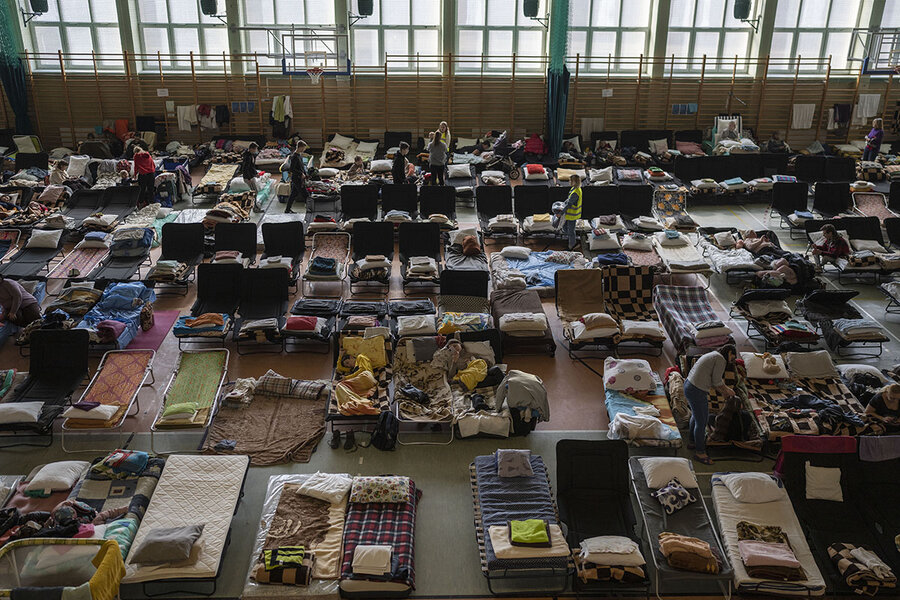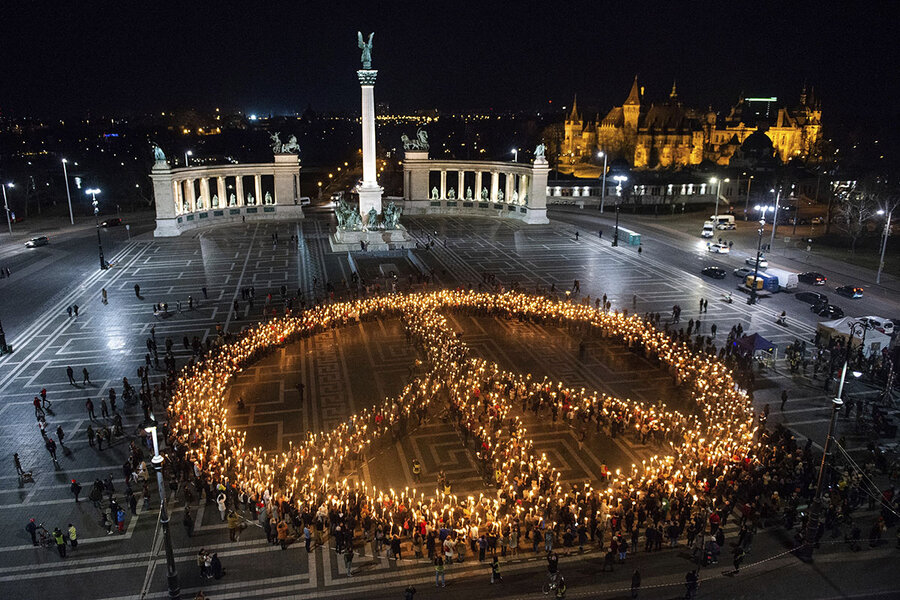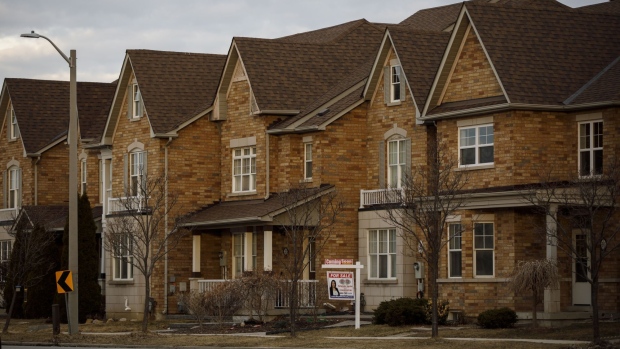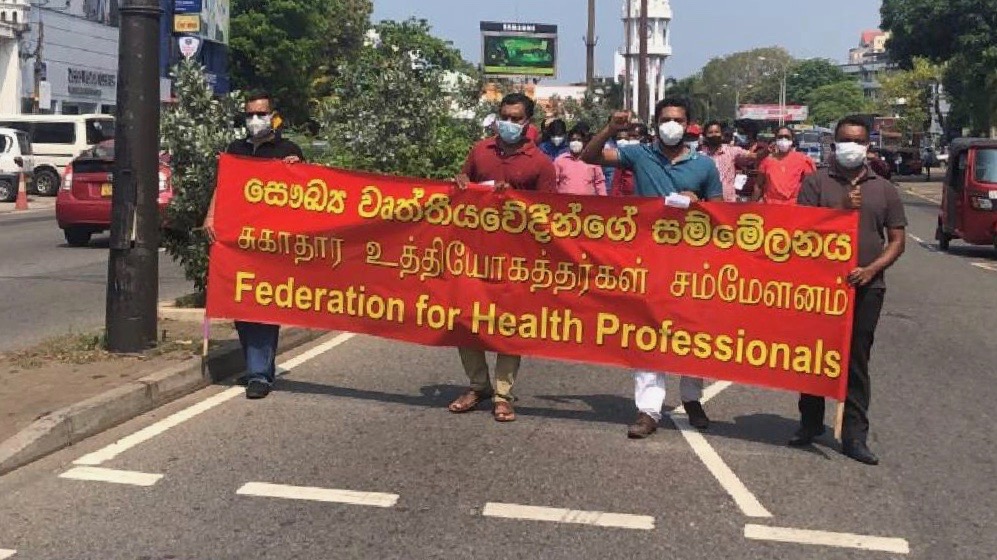
Darko Vojinovic/AP
Kyiv resident Polina Shulga and her 3-year-old daughter, Aria, run for a train to Budapest in the Hungarian border town of Zahony, March 7, 2022, as they flee the war in Ukraine. "I explained to her that we're going on vacation and that we'll definitely come home one day when the war is over," Ms. Shulga says.
March 24, 2022
By Monika Rębała Special contributor
Dominique Soguel Special correspondent
PRZEMYŚL, POLAND; AND BASEL, SWITZERLAND
When Victoria, a retired university lecturer, fled Ukraine as the Russian military devastated her home city of Kharkiv, she didn’t have many options of where to go.
She has no relatives in Ukraine, or in other parts of Europe. But she still has a friend from school in Warsaw, the Polish capital, who she used to visit frequently before the war began. So she got on one of the crowded trains leaving the city and headed westward.
But when she arrived in the Polish border city of Przemyśl, she did not expect the warmth of the reception she got.
WHY WE WROTE THIS
After failing to help non-European refugees in the past, Eastern Europe is coming through for Ukrainians. The stark change suggests racism. That’s accurate, but not the whole picture.
“I was surprised that Poles received us so well. I travel to Poland regularly, and this time the Poles were nicer,” she says. “If you speak to someone, they help you right away. The attitude of Poles toward Ukrainians has changed.”
Władysław, a Polish volunteer with the Food not Bombs group feeding refugees at the Medyka border crossing, agrees: The Polish public’s generous outpouring of support to the Ukrainian refugees is not something he saw coming.
“We didn’t expect such a positive response from Poles toward refugees, considering what happened recently on the Belarusian border,” he says. He is referring to a tense standoff last year when Middle Eastern asylum-seekers were trapped in a freezing buffer zone between Poland and Belarus, which exploited the migrants to put pressure on the European Union. At least 19 people died, in part because the Polish government held good Samaritans back from aiding them.
“The question is how long this friendly attitude [toward Ukrainians by Poles] will last,” adds Władysław, who didn't give a last name.
Poland, like much of Eastern Europe, has a troubled relationship with outsiders, and a particularly dismal record handling asylum-seekers from outside Europe. But in a twist in fate and geography, Poland, Hungary, and other similarly closed-door Eastern European nations have been the hardest hit by the humanitarian crisis arising out of Ukraine’s refugee exodus.
And in a reversal of history, even the governments of Poland and Hungary laid out the welcome mat for Ukrainians. Charities there rushed to help the new arrivals. Grassroots and individual efforts have been notable – with Polish mothers even leaving baby strollers at the train station for Ukrainian women with small children.
But the contrast between the reception that Ukrainians are seeing now and the cold shoulder that refugees from Syria received during the 2015 refugee crisis in Europe is stark. Whereas just seven years ago Eastern Europe refused to take in more than a token number of asylum-seekers from the millions fleeing civil war in Syria, now they are throwing open their doors to those in a very similar situation.
Why?
“It is a very difficult conversation to have right now. You cannot deny the generosity and the scale of the crisis that Poland and other neighboring countries are having to respond to,” says Rachael Reilly of the Geneva-based Global Detention Project. But “look at what happened in Syria, look at what’s happened in Afghanistan, look at Iraq. Refugees from all those countries were fleeing similar situations of aggression, conflict, warfare, human rights violations, hostility, and they haven’t received the same reception.”
A tale of two migrations
The speed and scale of the refugee crisis are unprecedented. So is the European response.
More than 3.5 million Ukrainians have fled their country since the start of Russia’s invasion on Feb. 24, with the vast majority traveling westward to EU territory. The lion’s share – over 2 million – have gone to Poland, according to figures from the United Nations High Commissioner for Refugees. And they have been broadly welcomed, both in Eastern Europe and across the EU.

Petros Giannakouris/AP
Refugees from Ukraine rest inside an indoor sports stadium being used as a refugee center in the village of Medyka, Poland, located just next to Ukraine, March 15, 2022.
“All those fleeing [Russian President Vladimir] Putin’s bombs are welcome in Europe,” President of the European Commission Ursula von der Leyen was quick to declare. In a rare display of solidarity, EU ministers unanimously granted blanket protection to Ukrainian refugees, making first-time use of a 2001 directive. The move allows them to live, travel, and work in the bloc for three years – a sweeping and critically needed empowerment of the displaced Ukrainians.
In 2015, the scale of the crisis was similar but the quality of the reception was far less welcoming. That year saw more than 1.3 million people arrive in Europe seeking asylum, primarily from Syria’s civil war, but also from turmoil in Afghanistan and Iraq. And with a few notable exceptions like Germany, which took in more than a million refugees, most European countries declined to accept them in substantial numbers.
The issue was particularly acute in Eastern Europe. In Hungary, right-wing conservative Prime Minister Viktor Orbán erected a 100-mile-long razor-wire fence to keep out asylum-seekers from the Middle East, casting Muslims as a civilizational and security threat.
“Those arriving have been raised in another religion, and represent a radically different culture. Most of them are not Christians, but Muslims,” he said in September 2015. “This is an important question, because Europe and European identity is rooted in Christianity.”
And in Poland, which was voting for a new parliament in 2015, the centrist government agreed to take in only about 9,000 asylum-seekers. The populist-conservative Law and Justice party, which came to power later in the year, reneged on the deal after party officials suggested that refugees could be terrorists or carriers of disease.
“Real refugees”?
Clearly, the Ukrainian refugee crisis is being seen very differently from the one in Syria, where Russia helped government forces reduce cities to rubble. Some argue the key difference from earlier refugee crises is that the Ukrainian refugees are mostly women and children, but that doesn’t bear up to scrutiny. Women and children were present – along with men – in 2015.
“It cannot be challenged that there is a sense that Ukrainians are Europeans and there is a sense of solidarity in some parts of Europe that applies to Ukrainians but does not apply to Syrians or Afghans, or people from Ethiopia and Eritrea, or Somalis,” says Camille Le Coz, a senior policy analyst with the Migration Policy Institute Europe in Brussels. “This is considered a European crisis.”
Biases around nationality and culture play a large part in that, Ms. Reilly says, pointing to the justifications offered by national leaders for their sudden change of heart toward refugees.
For example, she cites Bulgarian Prime Minister Kiril Petkov. “These people are Europeans. ... These people are intelligent, they are educated people,” said the centrist leader early on in the Ukrainian crisis. “This is not the refugee wave we have been used to, people we were not sure about their identity, people with unclear pasts, who could have been even terrorists.”
The rhetoric of politicians reflects the perception that Ukrainians are “real refugees’’ and pose no threat, unlike those who fled conflicts outside the European continent. The apparent shift in attitude is in many ways “specific” to the Ukrainian context and still “very tainted by racism and xenophobia,” Ms. Reilly says.
For Witold Klaus, a professor at the Institute of Law Studies of the Polish Academy of Sciences, the primary reason for the reception of Ukrainians, at least in Poland, is the “very positive narrative of the government and the media around the refugees.” He points to the negative portrayal that the government framed the Syrians with in 2015, as compared with the positivity that it showed in bringing some 900 Afghan refugees to Poland last year during the West’s withdrawal from Afghanistan.
“They were treated well, and received help,” he says. “The thing that has the biggest impact on how the majority of the Polish society treats refugees is therefore what kind of narrative will be built by those in power and the media. It matters if it is a narrative based on fear and xenophobia, or on mobilization and willingness to help.”
Double standards are still evident now at the border, says Władysław, the volunteer aid worker.
“A few days ago, we were the only group helping refugees of a different skin color; they were treated very badly here,” he says. “Polish border guards drove up here in cars to take the refugees, but nobody wanted to take non-Ukrainians in.
“Why? We simply defend ourselves from what we don’t know.”
“Ukrainians, we know them”
Familiarity fuels solidarity, Władysław adds. “Ukrainians, we know them, we work together, we live in the same cities. That’s why we want to help them.”
About 2 million Ukrainian workers were already in Poland before this crisis, many of them economic migrants working low-end jobs. While Poles and Ukrainians have clashed, like any longtime neighbors, they have much in common as well, including similar language and culture.
Polish goodwill toward Ukrainians has been increasing since the fall of communism, with a spike in positivity coming in the last two to three years. Marta Jaroszewicz, an assistant professor at the Centre of Migration Research at the University of Warsaw, credits the COVID-19 pandemic for that, as Poles came into greater contact with Ukrainians who work in services, including delivering parcels and food during lockdowns. “We’ve started to get to know each other better.”
Michał Szachmat, a translator and member of the Association of Ukrainians in Poland, only hopes the goodwill will last. On his mind are memories of being punched in the teeth by locals in Przemyśl a few years ago for singing Ukrainian songs with his friends by the river.
Poland’s relationship with Ukraine has been marred by memories of the Ukrainian Insurgent Army (UPA), a nationalist paramilitary group operating in the region during and after World War II. The UPA massacred Poles in the border areas with Slovakia and Ukraine, which had been inhabited by a Ukrainian minority for generations. Communist authorities eventually forcibly resettled the Ukrainians, including Mr. Szachmat’s grandparents, in 1947 to weaken the UPA.
“Now I see how kindly the Poles living in Przemyśl are toward Ukrainians fleeing from the war ... but I’m afraid that politics may change this,” he says. “When the war ends, some people will return to Ukraine, but others will stay. Living under one roof might be full of challenges.”
Those who fight against Russia
In Hungary, however, that same degree of familiarity is not present.
Hungarians have historically viewed themselves as closer to the Western cultural sphere and Ukrainians as members of the East, says Hungarian historian Krisztián Ungváry, who specializes in Eastern European history and minority questions. “Ukraine was another part of the world.”
While Poles are able to understand a bit of the Ukrainian language, that is not the case for Hungarians. Religion is another point of divergence: The majority of Ukrainians identify as Orthodox Christians, whereas Christians in Hungary (and Poland) are Roman Catholics.

Anna Szilagyi/AP
People use lights to create a peace sign for Ukraine at Heroes Square in Budapest, Hungary, March 9, 2022. Russia's invasion of Ukraine has set off the largest mass migration in Europe in decades, with more than 3.5 million people having crossed from Ukraine into neighboring countries.
In more recent times, Ukrainians came as guest workers, primarily filling blue-collar jobs. Many of them belonged to the Ukrainian Hungarian minority, so they spoke the language but were still viewed as holding a lower social status, says Dr. Ungváry.
But aid groups and ordinary Hungarians from across the political spectrum have been central to efforts to assist more than 450,000 new arrivals from Ukraine. That may be in part because there’s a shared worry around the Ukrainians’ persecutor: Russia.
“The danger of Russia has united Ukrainians and others,” says Dr. Ungváry. “The history of Ukraine is absolutely different from the history of Hungary. ... The only topic in common in recent times is Putin and the question of East versus West.”
“This is very, very emotional for many Hungarians,” says Márta Pardavi, co-chair of the Budapest-based Hungarian Helsinki Committee, an organization working on refugee issues. “The pictures are very reminiscent of [the Soviet crushing of the Hungarian Revolution of] 1956, when Hungarians saw the Russians invade Budapest and there were tanks on the streets and people died and refugees had to flee Hungary.”
The sympathy for Ukrainians in the face of a common enemy runs even stronger for Poles. Dr. Klaus says, “We fear Russia and support those who are fighting the Russian aggressor. Those who fight against Russia, which has long been a declared enemy to us, elicit our sympathy.”
Dorottya Czuk contributed reporting from Budapest, Hungary, to this story.







:quality(70)/cloudfront-us-east-1.images.arcpublishing.com/mco/BQUVTAX27NEHRF2ZWHEJDBZUFA.jpg)
:quality(70)/cloudfront-us-east-1.images.arcpublishing.com/mco/ZWO7IAMSYNBV3J42UAWSYAJDWI.jpg)
:quality(70)/cloudfront-us-east-1.images.arcpublishing.com/mco/IUV3SS3XERDTHNFJK47W2FVO2I.jpg)
:quality(70)/cloudfront-us-east-1.images.arcpublishing.com/mco/54WO4DAR6NEBRLB34HCSFUQ7KQ.jpg)


